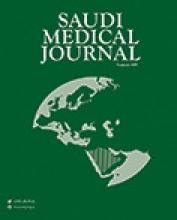Abstract
OBJECTIVE: To determine the level of resistance to the widely used antipseudomonal antibiotics in clinical isolates of Pseudomonas aeruginosa (P. aeruginosa).
METHODS: The microbiology database of all clinical isolates of P. aeruginosa at the Armed Forces Hospital, Riyadh, Kingdom of Saudi Arabia, from January 1999 to December 1999 was reviewed. The antimicrobial susceptibilities were determined by a standardized method.
RESULTS: Seven hundred and four P. aeruginosa isolates were tested. These strains were commonly isolated from surgical patients followed by intensive care units. Respiratory tract was the most common source of isolation. The antibiotic susceptibility rates were as follows: ciprofloxacin 92.2%, meropenem 91.6%, imipenem 90.2%, amikacin 85.8%, ceftazidime 81.8% piperacillin/tazobactam 81.3% and gentamicin 77.7%. Among 704 strains 6.4% were designated as being multidrug resistant. These were commonly isolated from respiratory tract specimens of patients in intensive care units.
CONCLUSION: The clinical significance of these findings is important in the selection of appropriate empiric treatment of serious P. aeruginosa infections. It emphasizes the importance of a conservative approach to antibiotic therapy and continued antimicrobial susceptibility testing surveillance programs to curtail the problem of antibiotic resistance.
- Copyright: © Saudi Medical Journal
This is an open-access article distributed under the terms of the Creative Commons Attribution-Noncommercial-Share Alike 3.0 Unported, which permits unrestricted use, distribution, and reproduction in any medium, provided the original work is properly cited.






